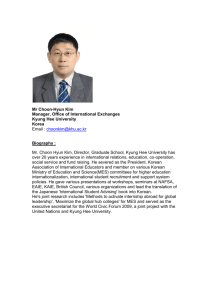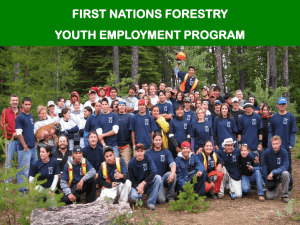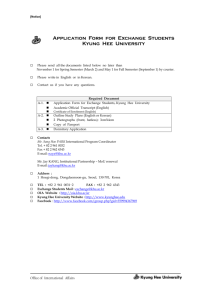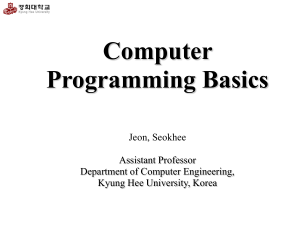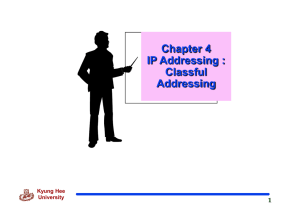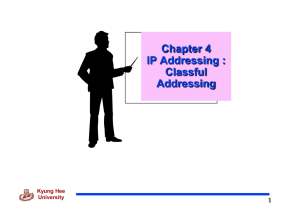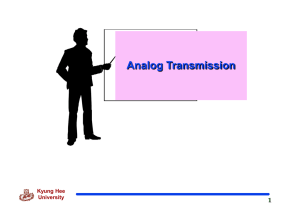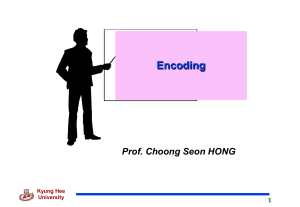Presentation Chang
advertisement
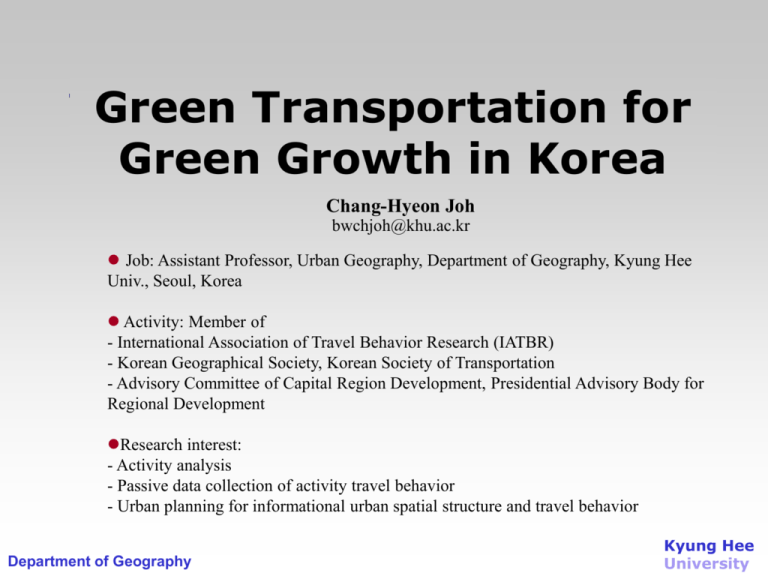
Green Transportation for Green Growth in Korea Chang-Hyeon Joh bwchjoh@khu.ac.kr Job: Assistant Professor, Urban Geography, Department of Geography, Kyung Hee Univ., Seoul, Korea Activity: Member of - International Association of Travel Behavior Research (IATBR) - Korean Geographical Society, Korean Society of Transportation - Advisory Committee of Capital Region Development, Presidential Advisory Body for Regional Development Research interest: - Activity analysis - Passive data collection of activity travel behavior - Urban planning for informational urban spatial structure and travel behavior Department of Geography Kyung Hee University Outline Governmental efforts Discouraging car use vs. encouraging public mode use Campaign with encouraging policy measures Mobility management measures for CO2 reduction Travel – Activity- Urban spatial structure Discussion Department of Geography Kyung Hee University Governmental efforts 1. Motivation National energy consumption: Industrial (57%), Transportation (21%), HH & Commercial (20%) Emission in transportation sector: 5% annual increase (‘90-‘07) Policy efforts: Bus (more major intercity lines), Train (more double track lines), Car (more parking lots for limited maximum) Yet, transportation overall maintains car-oriented systems Road’s modal split: Road 82% of passenger, 73% of freight Car 94% of CO2 in transportation Inefficiency: Road consumes 11 times more than rail. # Cars: 16 million in 2008 22 million in 2020 Low rate of transportation SOC investment for the rail: Road 50%, Rail 23% Public modes’ modal split: 53.4% in 1996 51.8% in 2005 Department of Geography Kyung Hee University 2. Policy strategies Governmental expenditure: % 2009 2020 Road 57.2 40 Rail 29.3 50 Sea 13.1 10 Air 0.4 0.1 2010: 5000 million for road, 3500 million for rail from total 200,000 million Euro Green Growth Policy 1: TDM Green Growth Policy 2: Encouraging pedestrian and bike mode Green Growth Policy 3: Encouraging transit Green Growth Policy 4: Encouraging rail-sea link Green Growth Policy 5: Green Transportation Technology Department of Geography Kyung Hee University 3. Greenhouse Emission Policy Goals Policy goal in 2020 (CO2 emission in million ton) total transportation 246 reduction National emission reduction goal by 2020: 30% off from BAU (4% off against 2005; 246 m ton off against expectation) Department of Geography Kyung Hee University Transportation sector 46 reduction National emission reduction goal by 2020 in transportation sector: 33-37% off (20-24% off against 2005; 46 m ton off) Department of Geography Kyung Hee University By sector Department of Geography 41% policy, 59% technology Kyung Hee University Actual expectation To achieve the gov’s goal, base 2012 should be 41.37 million ton CO2 . But actual expectation is: base 2012 car 10% modal change truck 20% network change car 10% hybrid 10% green techno EU efficiency ITS 20km/h operation Hi-pass m t CO2 55.60 52.94 49.08 52.05 55.22 53.00 52.12 55.60 % 4.8 11.7 6.8 0.7 5.0 7.2 0.2 Combination of these is stressed. However, policy for transportation itself has limited effect. Department of Geography Kyung Hee University Emission monitoring companies governmental big bldg logistics companies Energy consumption limit monitoring system (such as GB’s national atmospheric emissions inventory (NAEI)) 2010 46 (500,000 toe or higher) central governmental bldg local governmental bldg 2011 222 (50,000 toe or higher) 2012 423 (2 toe or higher) all governmental bldg 10,000 toe or higher more than 100 vehicles KOTEMS: Korea Transport Emission Management Systems Monitoring by evaluating the sustainability in transportation sector variable indicator annual amount in transportation sector greenhouse gas amount per person in transportation sector environmental amount per m2 in transportation sector social economic Department of Geography air pollution amount per person in transportation sector traffic safety death toll by traffic accidents per person, per auto modal split transit modal split air quality traffic congestion cost per person Kyung Hee University Discouraging car use vs. encouraging public mode use Comparative studies: Impacts of gasoline price increase & transit improvement Auto traffic volume (# cars) change when oil price increase by 1% total period -0.5261% low period -0.9240% high period -0.1799% Jan. 2000 to Jun. 2004 (low oil price period), Jul. 2004 to Dec. 2008 (high oil price period) Elasticity in low period is 6 times higher than that in high period. Transit use (# persons) change when oil price increase by 1% increase by 0.18% Jan. 2000 to Dec. 2008 No significant difference between high and low periods is found. Impact of transit system improvement transit use people increase by 4.19% Price impact is higher to auto than to transit. Impact of oil price on the car use is limited in high period like these days. To have an impact, high increase of gasoline price needs to be placed. Impact on transit use is limited in all periods. Transit improvement policy is more effective. Department of Geography Kyung Hee University Campaign with encouraging policy measures Weekly no-driving day program in Seoul reduces daily car use by 3.66%. Car-dependent drivers are less likely participate in the program Survey on attitude to TDM measures Public transportation strategies received as the key elements. Department of Geography Kyung Hee University Mobility management for CO2 reduction MM Survey on 327 individuals’ attitude and actual implementation of CO2 reduction Department of Geography Kyung Hee University Freq, # persons MM effect on car use freq per purpose commuting freq 336 291 292 13.4 13.1 Before MM 1 week later 1 month later ↓ 1 week rate % 1 month person 177 154 151 13.0 14.7 non-work (weekday) freq person 90 63 44 31 50 33 51.1 50.8 44.4 47.6 non-work (weekend) freq person 258 175 231 134 228 136 10.5 23.4 11.6 22.3 total freq 684 566 570 17.3 16.7 person 415 319 320 23.1 22.9 Other TDM effects (before and after) 4.19 MM (1 month later) Integrated transit system (transfer cost saving) Bus-only lane in expressway Toll charge (Main entry to downtown) Weekly no-driving day program (Seoul) Department of Geography Kyung Hee University CO2 MM effect on CO2 reduction ↓ rate Before MM 1 week later 1 month later 1 week 1 month commuting 586.8 kg 489.6 kg 502.2 kg 16.60% 14.40% non-work (weekday) 149.4 kg 69.3 kg 74.7 kg 53.60% 50.00% non-work (weekend) 477.9 kg 431.1 kg 430.2 kg 9.80% 10.00% total 1214.1 kg 990.0 kg 107.1 kg 18.50% 17.00% Estimated effect of MM on the CO2 emission (million ton) Department of Geography Kyung Hee University Travel – Activity- Urban spatial structure More than just green transportation “ War in Iraq is inevitable. That there would be war was decided by North American planners in the mid-1920s. That it would be in Iraq was decided much more recently. The architects of this war were not military planners but town planners. War is inevitable not because of weapons of mass destruction, as claimed by the political right, nor because of western imperialism, as claimed by the left. The cause of this war, and probably the one that will follow, is car dependence. … Motor vehicles are responsible for about one-third of global oil use, but for nearly twothirds of US oil use. In the rest of the world, heating and power generation account for most oil use. The increase in oil prices during the 1973 Arab oil embargo encouraged the substitution of other fuels in heating and power generation, but in the transport sector there is little scope for oil substitution in the short term. ” Car Wars (Ian Roberts) Department of Geography Kyung Hee University Better approach? * Travel (XXX) * Activity Travel (X) * (Daily) activity Urban spatial structure Travel (O) Reasoning Traditional industrial land-use IT-based postmodern or web2.0/3.0 land-use Accessibility should not be the car-driven mobility Compact urban structure – high accessibility – high frequency – shorter total travel distance Higher accessibility and lower emission Department of Geography Kyung Hee University Recent research on urban structure and travel behavior in Metropolitan Seoul Compact urban development increase transit use Compact city’s planning factors 5-D (density, diversity, design, destination accessibility, distance to transit) variables affect modal split between car and train. Home-work separation high car proportion, low green modes proportion More transit stops and stations increase transit proportion High road density and JC density increase car proportion Low population density area high car and non-motorized modes proportion High population density area high outer travel proportion (more using transit) Transportation problem is not transportation itself. Derived characteristics require more fundamental solution: How people build city via social life determines the shape and volume of the passenger and freight transportation demand. Mixed land-use, compact urban spatial structure, transit-oriented transportation systems Department of Geography Kyung Hee University Political matter GTX vs. Express Underground Highway Under the scheme of Greater Seoul Department of Geography Kyung Hee University Discussion - Unequal economic development: much for the capital region Nationwide inequality problem higher intercity travel demand (freq) - Road-oriented transportation system: car driven heavy CO2 emission - Distant home-work location distribution: long distant travel (dist) The most serious problem in the metropolitan region - Nationwide local governance former gov’s ideal in regional policy = Northern Europe - Rail-oriented transportation network: OK - Alternative urban spatial structure: Postmodern, ICT-based flexible production/consumption society Not the industrialized land-use (massive residential, commercial, industrial complexes separated) But multi-dimensional, personalized instant use of urban spaces Back to the original shape of the urban spatial structure, in which residents’ communities play the key role in daily life and travel Increase trip frequency, decrease total travel distance Increase accessibility and decrease emission Improve quality of life Department of Geography Kyung Hee University
